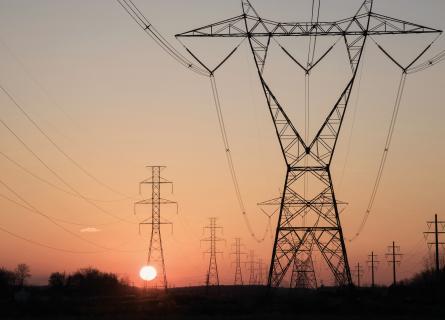
Grid Capacity Challenges in Sweden
Against a backdrop growing concern over climate change, COP25 is taking place in Madrid in early December 2019. Decarbonisation of the whole economy is rising higher up the political agenda. Net zero targets are being set by more and more countries and are discussed now at a European level. The 1.5C ambition already targeted in the Paris Agreement translates for Europe to a 95% economy-wide decarbonisation target. Whether 95% reduction or net zero by 2050 (or earlier) what is clear is that the building renewables in electricity sector will not solve the challenge alone. Decarbonising the whole economy means more than just building wind farms. But even if we can build low cost wind farms – we still need to transport the electricity they produce to the end consumers.
In this article we focus in on one area that creates a barrier to economy-wide decarbonisation – that of grid constraints – and we focus in on the situation in Sweden which faces a particular set of challenges.
Sweden is growing and things are moving fast. Traditional industry is being renewed, and growth in robots, cloud services, artificial intelligence (AI) and other digitalization phenomena are leading to a strong increase in the demand for power. At the same time, utilisation of the once well-dimensioned electricity grids is reaching unprecedented levels. As a result, providing grid access for new users and connections is no longer straightforward. Adding to the challenges, several large grid development projects have lingered for years in complex concession processes, for as long as 15 years.
A study conducted by AFRY in 2018 shows dramatic implications of grid capacity restraints; if the situation is not improved, as much as 16 GW of new connection,s representing an annual socio-economic value 150 billion SEK, may be lost by 2030. Already today, the estimated socio-economic cost of insufficient grid capacity is as high as 80 billion SEK per year, not counting indirect effects. By comparison, the value of the full, Swedish electricity network is 170 billion SEK.
The lack of capacity hurts economic development, especially in southern and mid Sweden, by limiting electrification of transport, establishment of new companies, development of new urban areas, business and residential buildings. In particular, lack of grid capacity limits regional development in the larger urban areas like Stockholm, Gothenburg and Malmö.
There is no shortage of power generation, the issue is transmission and grid capacity. Growing demand is balanced by increased generation, especially from wind power plants. However, the majority of added wind power capacity is in the north, while the ageing nuclear plants in the south are phased out one block at the time starting this and next year for Ringhals 2 & Ringhals 1. The large power lines from the north to the south will not fully absorb the change and the transfer capacity (NTC) between northern and southern Sweden will be a bottleneck to a larger extent than it is today. It currently maxes out at 7000 MW NTC. Relatively little wind generation comes on-line in the south and it is not enough to compensate for the foreseeable strong demand growth. In low wind operational hours, southern Sweden relies on net import of energy from neighbouring countries. This deficit will be accentuated and calls for more exchange capacity, more generator capacity or a combination of both. The increased pressure on the backbone of the 400 kV- grid means that operational margins will diminish over the coming years. The system will be more exposed to faults in during high transmission hours. Faults in these hours are shown to be more challenging to mitigate. All in all, the over utilisation of the existing grid will have an impact on the reliability of the system but it is difficult to quantify by how much.
To deal with the lack of capacity, multiple measures and actions are required. While building more grid capacity is a high priority action and the ultimate solution, better use of existing rights of way, combined with demand side flexibility, provides a different set of tools to manage the crisis: Regarding the latter, the key issue is how to adjust demand with minimised socio-economic cost, and how to create efficient market places to ensure this is happening. Regarding the former, the current operational rules for use of rights of way and the existing grid may be changed to improve utilisation. Along with better market design for flexibility and simpler, targeted investments in alternatives to grid, like grid size battery storage, these two families of measures could mitigate at least some of the capacity constraints. There is an obvious need to weigh socioeconomic costs of chosen reliability levels with socio-economic costs of severe grid capacity constraints.
Speeding up grid concession and construction
Democratic processes take time. While a fundamental and highly-valued part of our democracy, streamlining concession and investment processes will be necessary in order to catch up with the current backlog in grid capacity. This is especially true for transmission grids, where lead times for construction regularly exceed ten years. At the same time, insufficient communication and coordination between stakeholders aggravate the challenges and the time spent on decision processes. Enhanced planning and coordination processes should be introduced as to ensure that all important elements in understanding the future need for capacity are properly dealt with. Better coordination not only contributes to better investment decisions, it also clarifies “the good story” to the wider public and strengthens public acceptance of new capacity projects.
Economic incentives and financing are important elements too. Many of the larger grid owners will be required to lower their tariffs and thus their income in the forthcoming regulatory period. Lower tariffs are justified with consumer protection; however, lowered tariffs are also likely to result in reduced grid investments.
Finally, both organisation and capacity of public bodies could be strengthened and improved. Instead of sequential proceedings, parallel processes across different public bodies should be developed where possible. Staffing in relevant bodies and offices should also be increased as to avoid unnecessary delays in public proceedings.
Demand side management (DSM)
DSM can be defined as an array of activities to alter utilities’ load shape and/or energy consumption patterns. It can be utilised to shift part of the electricity demand from peak demand hours or unfavourable electricity generation hours, to valley hours or favourable electricity generation hours. The fundamental idea is to guarantee that demand and production are continuously being balanced, whilst reducing the stress on the transmission and distribution lines.
The incorporation of DSM into the electricity market has been made possible through technological advancement in communication and the rollout of smart meters. Its implementation in the electricity market can be facilitated, amongst other strategies, by load-based time varying grid tariffs. These could be employed in order to reflect the necessity of decreasing load by showcasing high prices, or, conversely, to incite power consumption by exhibiting low prices. More advanced, dynamic grid tariff models may be much more targeted at resolving acute congestion and capacity constraints. However, our studies on end user behaviour and preferences clearly show that end users are unlikely to accept and react to complicated, dynamic pricing models unless combined with automated load and energy management systems. In consequence, third party players like energy service companies (ESCOs) are crucial in order to help end users utilise their available flexibility. New business models require a financial basis: This could be realised either directly through the price signal in the grid tariff, while it could also be organised as regional and local flexibility market places, where the grid operators pay aggregators like ESCOs to provide flexibility in specific locations when needed.
The demand side flexibility reserve is already substantial, and with the rise of e-mobility it is growing. In the building sector, electric space- and water heating, ventilation and cooling are all to some extent flexible loads that can be shifted at least between hours. EV charging, especially at home, is highly flexible and can easily be shifted from daytime to night-time.
Introduction of behavioural incentives, like neighbourhood competitions, could be equally important to actually mobilise the flexible demand resources in the system. In this regard, new, customer-focused players like energy service companies will play a central role.
Enhance the use of the existing grid
New technology and digitalisation not only enable end users to play a much more active role and providing flexibility and load control; they also provide grid companies with new knowledge and tools to utilise existing grid capacity better. New sensors, big data collection and analytical tools based on machine learning (ML) and artificial intelligence (AI) provide a range of new opportunities. Better information and control enables system operators to adjust risk assessments and operational rules for maintaining the desired level of safety and security of supply. Predictive analysis and targeted fault prevention will contribute to reduce down-time and revision periods. Real-time ambient- and grid temperature data enables optimal use of the grid through dynamic line rating (DLR) – where the available capacity actually increases during cold periods, at the same time as the typical Nordic demand is peaking due to heating load.
A part of the capacity challenge is related to short-term situations, like unexpected outages and system faults, or demand peaks of short duration. There are alternatives to building grids to handle such situations. Grid-sized batteries can help stabilise the grid, avoid outages and reduce system costs. Under current EU legislation, however, battery ownership and operation is outside of the regulated network business, and new business models and access to markets for relevant flexibility services must therefore first be put in place.
When designing the framework for new and relatively unknown types of major power system assets, an holistic perspective is required for provision of fit-for-purpose framework rules as functionality, value and usage will most likely span the range from grid capacity constraint alleviation to advanced real time power system control. These are very different values brought to the system and the overall investment case will most likely be dependent on several different revenue streams that need be co-optimised in order to prove a viable investment case.
In summary, with some intelligent choices it will possible to optimise the use of the existing and future grid and make sure that electricity consumers get the best value for money possible while also delivering on decarbonisation.




